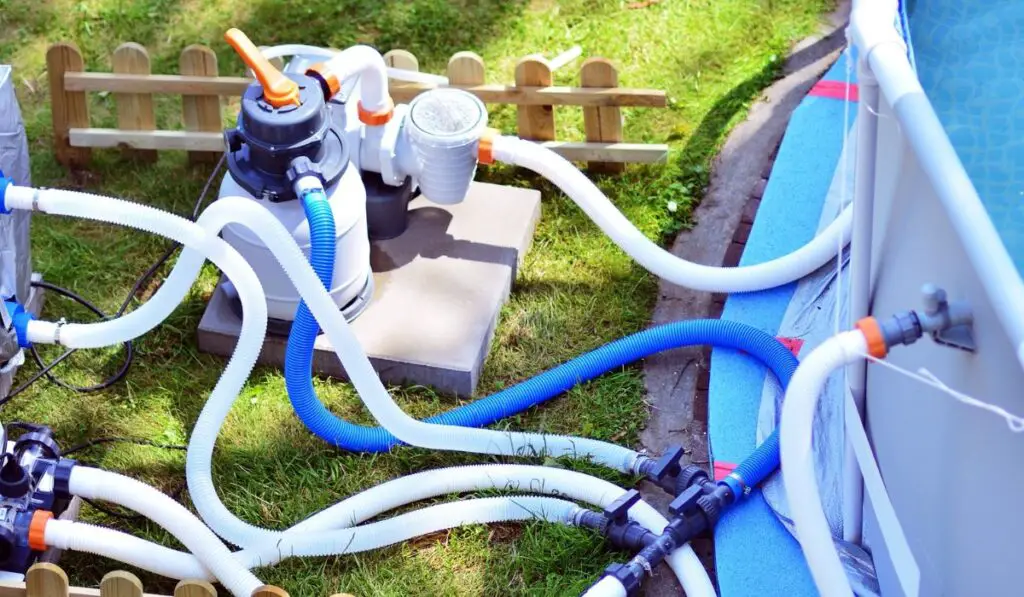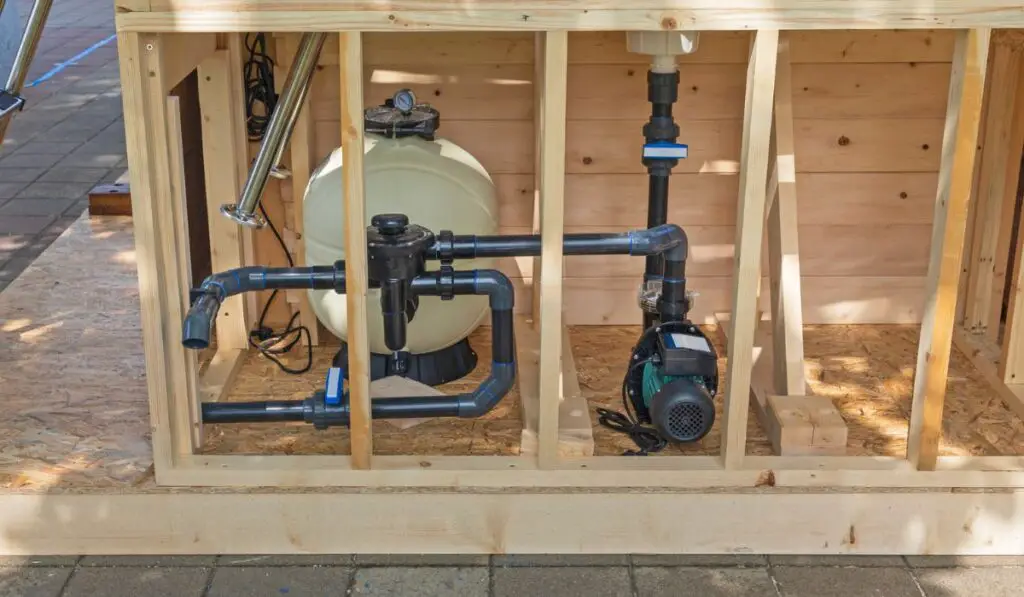Are you ready to dive into your pool, but the pump just refuses to turn on? There’s no need to worry if your pool pump suddenly stops working, as the problem is surprisingly easy to diagnose and fix.
Your pump may not be turning on because of an electric issue, a clogged filter, or corroded bearings. To fix the issue, clean the strainer basket and impeller, replace worn-out bearings and o-rings, and clear the air-intake vents. If the problem persists, call a professional.
A pump filters out dirty particles, evenly distributes cleaning chemicals, and ensures smooth water circulation. But to perform all these vital functions, it needs to have a working motor. So let’s see why your pool pump isn’t working, how you can reset it, what you should do if it starts sucking in air, and how you can identify a clogged pump.
Reasons Your Pool Pump isn’t Working

If your pump is non-functional, your pool water won’t be able to pass through the filter, turning your pool into a cesspool of algae and bacteria. Your pool pump may not be working for several reasons, including:
A Power Issue
If the pump’s motor doesn’t work at all, a lack of power is probably the culprit. Here are a few troubleshooting steps you can try to fix the issue:
- First, make sure your pump is switched on.
- Check your home’s main electrical service panel for a tripped breaker or a blown fuse, and address these problems accordingly.
- If your pump is connected to a circuit that doesn’t provide enough amperage, the pump’s motor might hum but fail to operate fully. Likewise, if you’ve connected other electrical appliances to the circuit, the generated amperage may not be sufficient to power the pump.
- Check your building codes, as most require a separate circuit for the pool pump.
- Your utility company might experience power drops during heat waves. So contact the company to confirm that the issue is with your pump, not your power supply.
A Clogged Pump
A clogged pump impeller might prevent your pump from switching on. Here are the steps you can follow to unclog it:
- First, turn off the pump’s power at the circuit breaker.
- Next, open the basket lid and remove the pump basket.
- Using your hand, gently clean out any visible dust or debris from the impeller until you can spin it easily.
If you feel or see debris in the impeller but are unable to remove it, hire a qualified pool technician to open up your pump and repair or clean the impeller.
Corroded Bearings
If your impeller does not have any dirt or debris and seems like it should be working perfectly, your pump may have corroded bearings. Unfortunately, the only way to fix worn-out bearings is to replace the motor completely.
Resetting Your Pool Pump
While a few newer models are designed with self-priming functions, most pool pumps need to be reset to remove the air from the system and ensure smooth water circulation.
Here are the steps you need to follow to reset your pump:
- Switch off the pump: Whenever you’re working with water and electricity, it’s vital to ensure there’s no active electrical current. Switching off the pump at the breaker is also a good idea.
- Move the multiport valve to the recirculate position: This step will ensure that the water flows directly to the pool pump instead of passing through the filter.
- Lower air pressure: Open the air valve on the top of the pool filter to lower the air pressure.
- Clean the pump basket: Remove any dust or debris that might have been collected in the pool pump basket. You can rinse the basket with a garden hose if it’s too dirty. Make sure you check the o-rings for cracks as well.
- Fill the pump basket: Use a garden hose to fill the pool pump basket with water and then firmly secure the lid on top of the pump’s housing. It’s better to fill the basket slowly, so you can check whether the water is flowing into the pool pump lines or not.
- Switch on the pump: Open the air relief valve and turn on the pump. This should reset your pump, but if the water does not flow through the pump basket within a few minutes, turn off the pump and repeat the process.
- Close the air relief valve: Once the pump starts circulating water smoothly, close the air relief valve and turn the multiport valve to the filter position.
What to do When Air Gets in Your Pool Pump
Air usually enters your pool system through one of two ways: the skimmer (if you have a clogged filter or low water levels) or a leaky o-ring.
If the water level in your pool is low, you can quickly fix the problem by filling it up. You should also check the skimmer basket and clean out any debris that may have accumulated inside it. Filling the strainer basket with water and resealing it is also advisable.
If the pump still doesn’t work, check the o-rings for any cracks and damages, and replace them if you find any. It’s better to clean the pump impeller as well. Once you’ve removed the air from your pool pump, reset it to get the water flowing again.
How to Tell if Your Pool Pump is Clogged
There are several signs of a clogged pool pump, and some of the most common ones include:
- The pool pump is making loud, grinding noises.
- The water in the pump is swirling or moving slowly.
- The filter pressure is too low.
- The water flow is lower than usual.
- The pump basket is empty and doesn’t fill up with water.
How to Clean a Clogged Pool Pump
It’s straightforward to clean out a clogged pump. Here’s what you need to do:
- First, switch off the pump at the breaker.
- Next, remove the pool pump basket and try to touch the impeller with your fingers or a small piece of wire.
- Use a swirling motion to remove the accumulated debris and scoop it out by hand.
- Reassemble the pump and turn it back on.
How to Prevent a Clogged Pump

Here are a few things you can try to prevent your pump from clogging in the first place:
- Use skimmer socks in spring or any other time of year in which your impeller usually clogs.
- Line the inside of the pool pump basket using a nylon knee sock.
- Don’t turn on the pump if the pump basket is not in place.
- Trim back offending bushes or trees and try to reduce the amount of debris that falls into your pool.
- Twist and firmly lock the pump baskets before turning on the pump.
- Don’t turn on the pump if the pump basket is not in place.
- Trim back offending bushes or trees and try to reduce the amount of debris that falls into your pool.
- Twist and firmly lock the pump baskets before turning on the pump.
Other Troubleshooting Methods
If you’ve tried all the fixes mentioned above, but your pump still refuses to turn on, here are a few other troubleshooting methods you can try:
- Ensure the pool timer is functional and set to work when you want it to. If the timer is inoperational, your pump might not start.
- During heatwaves, a thermal overload can shut down your pump mid-operation. If this happens, allow the pool pump to cool down before restarting.
- An overheating pump motor can also shut down your pump during operation. Cleaning the air-intake vents and removing any accumulated debris can help remedy this issue.
If none of those above troubleshooting procedures fix your pump’s non-starting problem, go through the user manual for additional guidance. You can also contact the manufacturer for detailed instructions or ask for a referral to the closest authorized repair service.
However, keep in mind that if your pump has a faulty start capacitor––usually indicated by white, powdery residue or an oily discharge––or corroded bearings, it’s best to hire a professional for repair.
